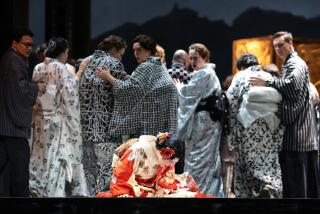OPERA REVIEW : DAVIES’ ‘THE LIGHTHOUSE’ OPENS SERIES AT OLD GLOBE
- Share via
SAN DIEGO — The truth about acoustics, a veteran acoustician was heard to mutter a few months ago, is that most people listen with their eyes, not their ears.
The corollary to that observation must be that what looks good, often seems to sound good.
Both propositions held up over the weekend when San Diego Opera inaugurated its new series, “Opera at the Old Globe,” with the local premiere of Peter Maxwell Davies’ chamber opera “The Lighthouse.” At the first performance Saturday night an initial period of acoustical mush soon gave way to clearer perceptions of what was being sung by the cast of three. Thereafter, and despite often overloud instrumental playing from the pit, most of the sung drama could be followed.
The visual advantages of the Old Globe certainly outweigh its under-resonant sound-profile. Views are unimpeded, distances short, from most all of the seats. Chamber music, heard here two summers ago courtesy of the La Jolla/Santa Fe connection, carries nicely through the hall. As often happens in auditoriums of this type, however, the orchestra pit, situated as it must be in the acoustical center of the room, tends to resonate more successfully than any other spot; the result can be instrumental domination of the operatic fabric.
More to the point, in the current showings of Maxwell Davies’ harrowing, 70-minute operatic thriller (to be repeated Wednesday, Thursday, Saturday and Sunday), the three singing actors cast in these roles bring only minimally ringing sounds to their performances.
“The Lighthouse”--first performed at the Edinburgh Festival in 1980, deals with the mysterious disappearance of three lighthouse keepers from their posts at a Scottish locale 86 years ago. The mystery remains unsolved, both in reality and in Davies’ operatic speculation. But the plot of this two-part drama--a prologue and main act, performed without intermission--posits a possible scenario.
On the way to its violent conclusion, Davies’ score offers an exceptionally colorful and varied--within 20th-Century stylistic limits, as usual--palette of sounds. The composer’s long-established mastery of instrumental and vocal devices in creating mood and character, tension and relief, seems complete. If Davies’ musical style were not so consistent and self-sustaining, one might call it eclectic ; since it always works, it should be labeled unique .
Conducted with a clear view to achieving its climax in an apprehendable and cumulative way by Karen Keltmer, the Saturday performance moved logically toward that end. And as staged concisely by Jack O’Brien, artistic director of the Old Globe, nothing visual halted the flow of musical logic. Kent Dorsey designed both the functional scaffolding-set and an effective lighting scheme.
Of the three singers--in what finally amounts to nine roles--the clearest in word and action was veteran baritone Harlan Foss, whose principal assignment was lighthouse keeper Blazes. Tenor Michael Ballam’s singing and acting reflected some of the contradictions in keeper Sandy. Basso James Butler failed to deliver large portions of Arthur’s words and revealed only minimal vocal resonance. None of the singers was helped by the dryness of the acoustics in the Old Globe.
More to Read
The biggest entertainment stories
Get our big stories about Hollywood, film, television, music, arts, culture and more right in your inbox as soon as they publish.
You may occasionally receive promotional content from the Los Angeles Times.










